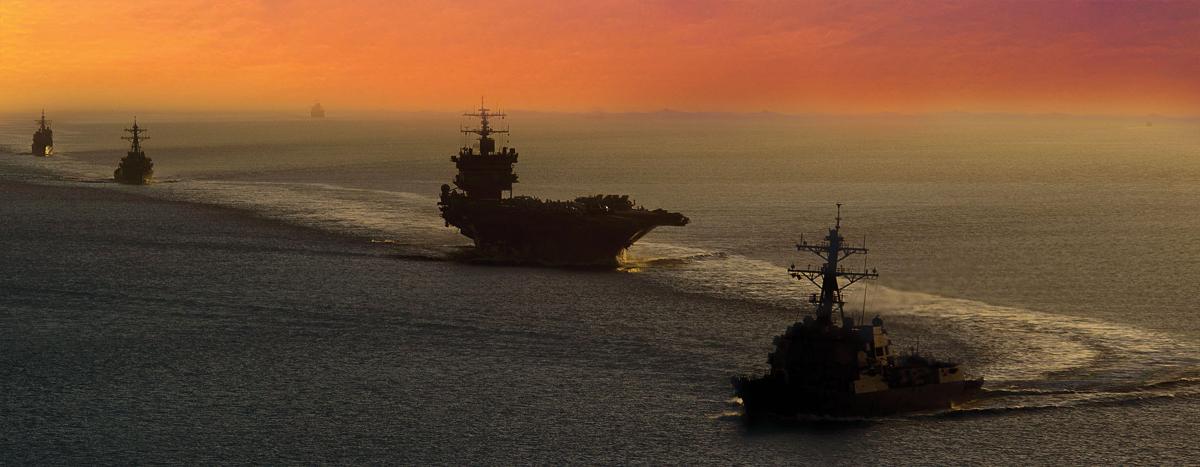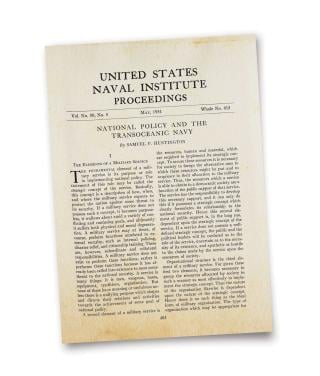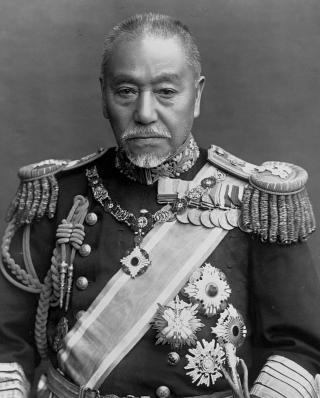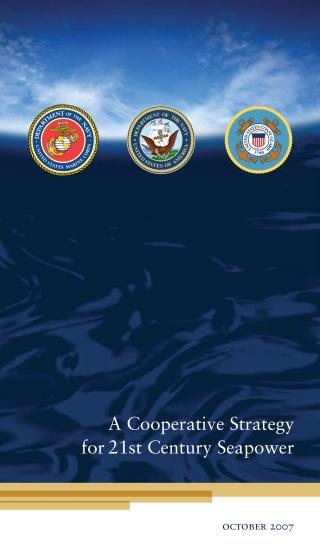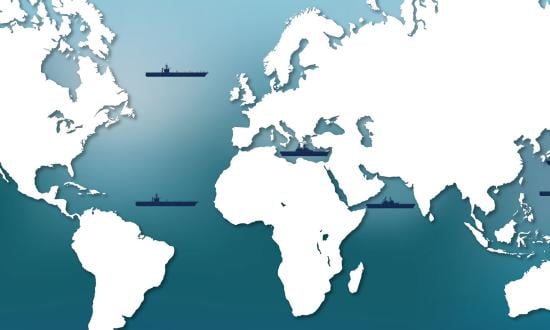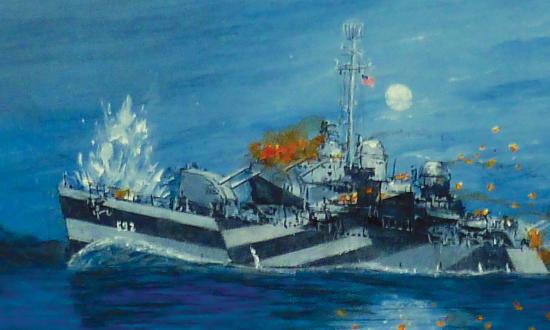“The gods refuse the crown of victory to those who rest content after a single triumph. They give it to those who exert themselves in peacetime training, who have therefore won before any fighting begins. As the men of old said, ‘After a victory, tighten your helmet strings.’”1
—Admiral Tōgō Heihachirō
Admiral Tōgō Heihachirō said these words to the Imperial Japanese Combined Fleet that had recently annihilated the Russian fleet at the Battle of Tsushima in October 1905. In his final instructions, Admiral Tōgō exhorted his shipmates to prepare themselves for the next war, whenever it might come, against whatever adversary might challenge them.
Fast forward eight decades. In the 1980s, no one doubted that the nearly 600-ship U.S. Navy was bred and ready for war. Its mission was not easy, but it was simple. Everyone, from senior admirals to junior sailors, knew, if push came to shove, their job was to put steel on target and the Soviet Navy on the bottom. The service locked its sights on the adversary. It adopted a pugnacious wartime strategy designed to take the fight to the Soviet Navy in its home waters. It would attack the Soviet Union’s flanks in support of the main effort in central Europe.2 The Navy exercised this strategy relentlessly, demonstrating its intention and will to sail into the teeth of Soviet defenses and hound, harry, and destroy every ship, submarine, and aircraft it could find—in addition to projecting power on Soviet shores.
Thankfully, as fate and an ably conceived and executed grand strategy would have it, the Navy never faced a test of arms against the Soviet Navy. But the victory it helped win proved even more decisive than Tsushima. It led to the collapse of the Soviet Union, and the mighty Soviet Navy returned to port and rusted away to a shadow of its former self.
The only downside to this happy turn of events was the U.S. Navy found itself without an adversary against which to set its sights and train to defeat. This is a bad place for it to be. Without an opponent to measure itself against, the Navy suffered “physical and moral degeneration.”3
The (Supposed) Cure: A New Strategic Concept
Samuel P. Huntington had diagnosed this chronic disease in the U.S. Navy less than a decade after World War II. The service that had won the greatest naval war in history suddenly found itself with no credible enemy fleet in sight, much less to fight. It had shrunk from a wartime high of 6,768 ships to just over 1,100.4 Naval aviation was struggling for its survival. In 1949, Congress canceled the United States—the Navy’s planned super carrier. The newly established U.S. Air Force was ascendent, especially in Department of Defense budget battles. The Navy seemed bereft of new ideas and incapable of expressing its continued value to the nation.
In his seminal May 1954 Proceedings article, Huntington argued the Navy’s malaise was caused by an outdated “strategic concept.” In his view, a strategic concept outlined a service’s “purpose or role in implementing national policy . . . a description of how, when, and where [it] expects to protect the nation against some threat to its security.” With no fleet to fight, Huntington argued, the Navy’s prewar strategic concept of command of the seas no longer pertained; it needed to change and conform to the postwar circumstances and the nation’s new national policy. Huntington then articulated a new strategic concept that called on the Navy to “apply naval power to that decisive strip of littoral encircling the Eurasian continent” through transoceanic power projection.5
At its core, then, Huntington saw a strategic concept as a marketing and fundraising tool, designed to answer the question, “What function do you perform which obligates society to assume responsibility for your maintenance?”6 And he made clear what the Navy had to do to answer:
Too often one still hears from the average American the question: “What do we need a navy for? The Russians don’t have one.” This attitude can only be overcome by a systematic, detailed elaboration and presentation of the theory of the transoceanic Navy against the broad background of naval history and naval technology. Only when this is done will the Navy have the public confidence commensurate with its important role in national defense.7
The Navy embraced Huntington’s transoceanic power projection. The concept had been beta tested in Korea and was later refined in Vietnam. More consequentially, the Navy took his admonition for a “systematic, detailed elaboration and presentation of the theory” to its institutional heart—albeit in a way even Huntington would likely find unhealthy. Since 1954, the Navy has been in a constant state of worry that if the American people lose sight of or disagree with its strategic concept, the dollars will stop flowing, ships will not be built, the fleet will shrink, and the service will be rendered irrelevant. Consequently, it is forever searching for the perfect description of its value to the nation. It has conducted “conversations with the country” and commissioned strategies to keep the flame of seapower burning in the hearts and minds of citizens and the need for a large, powerful fleet at the top of appropriation priorities in Congress.8
Thus, at the end of the Cold War, instead of tightening its helmet strings, the Navy gathered its inkwells and pens and started a quest for a new strategic concept.
The Search For A Post Cold–War Strategic Concept
The “Flight 0” version of the new strategic concept came in the form of . . . From the Sea, published in 1992. As described at the time, . . . From the Sea represented “a fundamental shift away from a global toward a regional perspective, and from open-ocean warfighting on the sea toward joint operations conducted from the sea.”9 The Navy–Marine Corps team, as part of the joint force, would:
provide powerful, yet unobtrusive presence; strategic deterrence; control of the seas; extended and continuous onscene crisis response; project precise power from the sea; and provide sealift if larger warfighting
scenarios emerge.10
These tasks were consistent with the four “mission areas” of the U.S. Navy outlined in 1974 by Vice Admiral Stansfield Turner, then president of the Naval War College: sea control, strategic deterrence, power projection, and forward presence.11 Just two decades after Huntington’s article, with the Soviet Navy rapidly gaining in size and capability, sea control had returned as the Navy’s primary mission and defining strategic concept, and it was the beating heart of the 1986 Maritime Strategy and the 600-ship Navy. Sea control was “intended to connote more realistic control in limited areas and for limited periods of time” than “command of the sea.”12
In hindsight, . . . From the Sea was little more than a readoption of Huntington’s concept of transoceanic power projection. However, forward presence gained much more attention in the new post–Cold War era. As explained in the new strategic concept:
The Navy and Marine Corps operate forward to project a positive American image, build foundations for viable coalitions, enhance diplomatic contacts, reassure friends, and demonstrate U.S. power and resolve. Naval forces will be prepared to fight promptly and effectively, but they will serve in an equally valuable way by engaging day-to-day as peace-keepers in the defense of American interests.13
This heightened emphasis on forward presence was caused, at least in part, by worry over the size of the Navy. With post–Cold War demobilization in full swing, the battle force had fallen from 592 ships in 1989 to 471 ships in 1992 and was still falling.14 During the 1993 Bottom-Up Review, the Office of the Secretary of Defense approved the Navy’s request to size its carrier force based on forward presence rather than warfighting requirements.15 Using forward presence as a force-sizing justification offered the prospect of slowing demobilization for all ship classes.
This seemed especially attractive as the regional combatant commanders (CoComs), empowered by the 1986 Goldwater-Nichols Act and with no checkbook to balance, began to exert a steady demand on forward-deployed naval forces for a variety of reasons.16 The Navy was happy, even anxious, to meet these demands, as they might provide justification for a larger fleet.
Unsurprisingly, then, in 1994, the Department of the Navy doubled down on the value of forward presence in the “Flight 1” version of its post–Cold War strategic concept, Forward . . . From the Sea. While this update acknowledged that “naval forces are designed to fight and win wars,” it elevated the importance and contributions of forward presence to a new level:
Our most recent experiences, however, underscore the premise that the most important role of naval forces in situations short of war is to be engaged in forward areas, with the objectives of preventing conflicts and controlling crises.17
Forward Presence As The New Strategic Concept
During the 1990s—a period with a national policy of “engagement and enlargement,” steady unconstrained CoCom demands for naval forces, and no serious naval competitor—the notion that forward presence could prevent conflicts began to take hold in the Navy.18 If it could help arrest the post–Cold War fleet drawdown, so much the better. Deterring bad behavior by regional actors through demonstrations and shows of force had always been understood as part of forward presence. But the idea that forward presence, in and of itself, could prevent conflicts more broadly was something new.
Also new was the lack of discipline in the requests for naval forces from regional CoComs. Having a carrier strike group, expeditionary strike group/amphibious ready group, or surface action group—or all of them together!—provided any combatant commander with powerful, mobile forces to deal with crises. Who would not want them? But as the fleet shrank, what was needed was a more rigorous process to balance demand with supply. That never materialized. So, despite the Navy not being sized to satisfy presence demands, the Pentagon generally acceded to them.19
The Navy tried to make do. Aggregate demand from the CoComs amounted to about 130 ships continuously deployed any given year.20 Throughout the 1990s, the Navy kept about 100 ships continuously deployed—similar to the number forward deployed with the 600-ship Cold War fleet—despite the year-to-year decline in the total number.21 Indeed, by 1999, the force had shrunk to 336 ships.22 Attempting to maintain such a high level of presence with a smaller fleet meant an ever-increasing percentage of the Navy was always deployed, causing operational and personnel tempo to surge.23 Slowly but surely, the Navy’s culture changed from its Cold War “readiness-centric” culture to a peacetime “deployment-centric” culture.24 In the process, the material readiness of the force began a long, inexorable decline, particularly in the surface warfare community. More worrisome, the overall readiness of Navy “surge” forces, expected to deploy should war come, began to decay.25
For this reason, by the early 2000s, forward presence had begun losing its sheen. In 2003, the Office of the Secretary of Defense was prodding the Navy to improve its surge capability, which was suffering after a decade of frenetic presence operations. In response, then–Chief of Naval Operations Admiral Vern Clark published the first version of the Fleet Response Plan (FRP). In addition to concerns about surge readiness, the FRP was a tacit recognition that the idea that forward presence alone could justify a larger battle force had proven to be a forlorn hope. These circumstances convinced the Navy it needed to revert to a readiness-centric culture that valued and emphasized surge forces as much as forward presence. Indeed, a key idea in the response plan was “presence with a purpose,” a not-so-subtle rejection of the idea of forward presence for its own sake.26
But the grip forward presence had on the service remained strong. The idea that forward presence could prevent conflicts was codified in the 2007 Cooperative Strategy for 21st Century Seapower, which declared, “We believe that preventing wars is as important as winning wars” [emphasis in the original]. And, given the logic of earlier versions of the post-Cold War concept, having ships forward was seen as the best way to prevent wars. Whether intended or not, the implication was that devoting combat-ready fleet assets to presence missions was as important as having surge forces ready to go to war. Moreover, the strategy raised the purported benefit of forward presence yet again, arguing it was essential to “protecting the existing global system of trade and security.”27
As its title suggests, a key aim of the 2007 strategy was to elicit international cooperation. Maintaining the status quo of the global system was central to this aim.28 But this formulation, however well intended, had a different impact on the Navy itself. Since the end of the Cold War, the advertised benefits of forward presence had progressively risen from a mission, to a force-sizing construct, to preventing wars and controlling crises, to protecting the global system. In essence, this thinking gradually elevated forward presence from one of the Navy’s enduring missions to its reason for being.
Secretary of the Navy Ray Mabus captured the Navy’s strategic concept of forward presence when he said, “Presence is what we do. It is who we are.”29
Be Careful What You Wish For
Few would argue forward presence is an unimportant mission. As Vice Admiral Turner described, presence:
is the use of naval forces, short of war, to achieve political objectives. The use of presence forces is for two broad objectives: to deter actions inimical to the interests of the United States or its allies; and to encourage actions that are in the interests of the United States and its allies.30
He went on to say there were two key tactics to accomplish these objectives: preventive deployments and reactive deployments. And there were five actions a naval force could execute or threaten to execute when assigned a presence mission: amphibious assault; air attack; bombardment; blockade; and exposure through reconnaissance. In addition, “almost any size and type of presence force can imply that the United States is concerned with the situation and may decide to bring other military forces to bear.”
Thinking about forward presence in this way should introduce a measure of rigor in deciding whether to undertake a presence mission requested by a regional commander. What is the precise objective of the mission? Are the naval assets assigned capable of accomplishing the objective? How will we know when the objective is accomplished? How long are we prepared to pursue the mission? Such rigor is notably absent when conducting presence operations to protect the existing global system of trade and security. Nearly any deployment, to whatever region, for however long, could reasonably be justified by such an expansive objective. And that helps explain why the incessant demands for naval forces from regional CoComs are seldom challenged, much less denied.31
More fundamentally, the idea that maintaining presence to protect the global system and prevent wars is equally important to winning wars is in direct conflict with the Navy’s own century-old standard for conventional deterrence: maintaining a fleet organized, trained, equipped, and ready for any military challenge to the United States. As Admiral William S. Sims—twice president of the Naval War College—wrote in 1915, “The mission of the fleet in time of peace is preparation for war.”32
Even such a forward-presence supportive document like The Cooperative Strategy for 21st Century Seapower warned, “There is a tension, however, between the requirements for continued peacetime engagement and maintaining proficiency in the critical skills necessary to fighting and winning in combat.”33 Just so. Ships conducting routine forward-presence missions burn combat readiness. Over time, unless the fleet was careful, an overemphasis on forward presence could lead to a decline in warfighting readiness, with potentially dire results.34
This appears to be exactly what happened. A 2010 review of the surface fleet, known widely as the Balisle Report, warned that the relentless operating tempo was threatening the long-term readiness of the surface navy.35 Seven years later, and a decade after adopting its new strategic concept of forward presence, there was a precipitous decline in fleet material readiness and training that contributed to four surface ship accidents in the Seventh Fleet area of responsibility, resulting in the deaths of 17 sailors. A comprehensive review of the issues that led to those accidents stated baldly: “Over time, the Navy’s ‘must do’ wartime culture was adopted for peacetime as long-term readiness and capability were sacrificed for immediate mission accomplishment.”36
The Navy’s Strategic Readiness Review conducted after the accidents offered a more bracing diagnosis:
The risks that were taken in the Western Pacific accumulated over time and did so insidiously. The dynamic environment normalized to the point where individuals and groups of individuals could no longer recognize that the processes in place to identify, communicate and assess readiness were no longer working at the ship and headquarters level.37
While the decline in material and combat readiness resulted from a calamitous combination of many decisions and policies, the relentless demands of the “deployment-centric culture” were a major contributor. Moreover, this culture contributed to a creeping sense that the Navy had lost or was losing its warfighting focus. In the estimation of former Secretary of the Navy John Lehman, “There is an emerging realization around the world that the U.S. no longer possesses naval superiority and could lose a war at sea.”38
Nonsense. Despite its serious problems, the U.S. Navy still is the strongest navy in the world, by a significant margin. With 11 nuclear-powered aircraft carriers and their multirole airwings, 50-plus nuclear-powered attack and guided-missile submarines, 100-plus P-8 maritime patrol aircraft, and the world’s largest unmanned aircraft ocean surveillance fleet, it likely possesses what Alfred Thayer Mahan referred to as “overbearing” naval power.38 While it may not be large enough to establish “command of the sea” everywhere on the global ocean, it is strong enough to guarantee no other navy can claim it.
Of course, as the old saying goes: “It’s not the size of the dog in the fight, it’s the size of the fight in the dog.” The Navy cannot be too enraptured by its superior ships, submarines, aircraft, and technology—or the number of freedom-of-navigation missions it performs. It must take sober consideration of its own 2017 Strategic Readiness Review and other inputs.39 The Navy cannot claim it can prevent any war, anymore than it can guarantee it will win all future wars. The only thing within its power is to be as ready as possible should war break out, and to be manned, trained, and equipped to fight any adversary on, over, under, and from the seas—relentlessly, ruthlessly, and without remorse—until the adversary is swept from its environs. A navy defeated in war is a much more worrisome strategic outcome than a navy that finds itself fighting a war it supposedly failed to prevent.
The hopeful idea that an ounce of prevention is worth a pound of cure helped get the Navy into its current readiness mess. To get out of it, it must change course and heed the 2018 National Defense Strategy: “The surest way to prevent war is to be prepared to win one.”
A Strategic Concept For Today: Para Bellum
If anything good comes out of the 2017 Navy ship accidents, it would be a renewed and sustained commitment to warfighting training and readiness and a deliberate moderation of forward-presence missions.
The early returns appear promising in this regard. The newest version of Naval Doctrine Publication (NDP) 1, Naval Warfare, drops forward presence altogether as one of the enduring functions of the naval service. In its place, it emphasizes naval diplomacy—“the application of naval capabilities in pursuit of national objectives during cooperation and competition below conflict.”40
The theme that forward presence is a means of generating influence is picked up in the newest “Flight 3” version of the Navy’s post–Cold War strategic concept, the 2020 triservice maritime strategy Advantage at Sea:
The Naval Service—forward deployed and capable of both rapid response and sustained operations globally—remains America’s most persistent and versatile instrument of military influence . . . [advancing] the prosperity, security and promise of a free and open rules-based order.41
The strategy’s description of forward presence as a means of diplomacy, influence, and advancing a rules-based order is less lofty than preventing wars and defending the global system. In addition to moderating the emphasis on forward presence and the benefits it brings, the Navy appears to be returning to a readiness-centric, warfighting culture. For example, after reading the Strategic Readiness Review, Rear Admiral Jeffrey Jablon, Commander, Submarine Force, U.S. Pacific Fleet, admitted he better recognized the trade-offs involved between presence and warfighting, and said the submarine force was in the process of balancing those trade-offs. “We focused the force on warfighting. So, we inculcated warfighting as part of our culture in everything we do with respect to man, train, and equip, vice a peacetime mission that we were more focused on before the comprehensive review.”42
Chief of Naval Operations Admiral Mike Gilday amplified this theme in his initial fragmentary order to the fleet: “Mission One for every Sailor—uniformed and civilian, active and reserve—is the operational readiness for today’s Navy.” His desired future state is “A Navy fully prepared to fight and win.”43
A Navy prepared to fight and win must have a high state of material readiness. Admiral Gilday’s first priority under the rubric of “warfighting” was therefore to improve ship maintenance and modernization. He said, “As we have learned over the past decade, it is cheaper to maintain readiness than to buy it back.” He ordered Naval Sea Systems Command to develop a plan within 60 days to improve and sustain the maintenance industrial base and to reduce the number of days lost to depot maintenance extensions.44
These steps need to be backed up by deliberate efforts to convince the Secretary of Defense and regional CoComs that Navy warfighting and material readiness should no longer be sacrificed on the altar of forward presence, and that the Navy will no longer confuse the ultimate end of winning a fight with merely being forward for the sake of being present. To drive this home, the Navy should urge and work with the Secretary of Defense to develop a new process to identify achievable objectives for presence forces, establish rigorous ways to design and implement the missions to accomplish them, and deny questionable requests for presence without purpose.
For example, the Secretary of Defense could ask all CoComs to submit yearly requests for naval presence. Requests would be examined by the Joint Staff and Navy, which would recommend to the Secretary of Defense which missions should be approved or disapproved. Once the Secretary approves the missions, the maintenance and operations costs to support them would need to be fully funded. The process also would need to account for emergent presence missions not considered during the annual program, with funding from the Office of the Secretary of Defense. Such a process would help ensure Navy presence “requirements” would be programmed and budgeted for in the Pentagon’s yearly defense program and prevent the degradation of fleet readiness caused by lax or reflexive approvals for presence.
Most important, the Navy must send a strong signal to the deckplates that sending forces on presence missions is subordinate to preparing for war. As NDP-1 says, “During times of peace, the most important task of any military is to prepare for war.” The naval service does not typically undergo a lengthy period of transition from garrison to deployed and operational status. Naval forces are operational as soon as they take in all lines.45
Reordering the Navy’s priorities is the basis for a new strategic concept I propose calling “Para Bellum”—Prepare for War. It would be based on credible readiness and the demonstrated rapid assemblage of combat fleet power to designated theaters. It would promote and preserve “overbearing” naval combat power, vice presence for its own sake, and would do more to demonstrate readiness and deter rivals as a result.
Keep It Simple
The Navy seems intent on replacing the strategic concept of forward presence. But there is no need for yet another vision, strategic concept, or maritime strategy. For those counting, there have been four post–Cold War attempts to craft a new strategic concept. It is unlikely another swipe will fix the Navy’s ills.
It is time to adopt simplicity of thought and strategic purpose. The Navy has long had a serviceable, if unacknowledged, strategic concept built on preparing for war, if only it would embrace it. Admiral Sims captured this concept more than 100 years ago, and it remains perfectly suited for the number one navy in the world—now facing not one, but two, potent adversaries. Indeed, Admiral Tōgō would argue, it is suited even for conditions when the Navy finds itself without an adversary in its sights.
Such a new strategic concept is simple but deceptively powerful. As Henri Frederic Amiel, a 19th century Swiss moral philosopher, wrote: “A man must be able to cut a knot, for everything cannot be untied; he must know how to disengage what is essential from the detail in which it is enwrapped, for everything cannot be equally considered; in a word, he must be able to simplify his duties, his business and his life.”46
Here is a potent message for naval strategists. By adopting a strategic concept that simplifies the duties and business of every officer and sailor to prepare for war, the U.S. Navy can gain a common purpose, correct its material deficiencies, enter a new era of realistic and demanding unit and fleet training, regain its warfighting mojo, and deter any potential adversary thinking about testing its mettle.
As the opening epigram advises, it is time to tighten up our helmets once again.
1. David C. Evans and Mark R. Peattie, Kaigun (Annapolis, MD: Naval Institute Press, 1997), 124.
2. ADM James D. Watkins, USN, “The Maritime Strategy,” U.S. Naval Institute Proceedings 112, no. 1 (January 1986).
3. Samuel P. Huntington, “National Policy and the Transoceanic Navy,” U.S. Naval Institute Proceedings 80, no. 5 (May 1954).
4. Naval History and Heritage Command, “U.S. Ship Force Levels, 1886–present.”
5. Huntington, “National Policy and the Transoceanic Navy.”
6. Huntington.
7. Huntington.
8. “Conversations with the country” was a series of “face-to-face, non-electronic public outreach meetings” conducted from November 2006 through 2008 in support of the development of the Cooperative Strategy for 21st Century Seapower. See Peter M. Swartz with Karin Duggan, U.S. Navy Capstone Strategies and Concepts (2001–2010) (Alexandria, VA: CNA, December 2011).
9. The Honorable Sean O’Keefe; ADM Frank B. Kelso, USN; and Gen Carl E. Mundy Jr., USMC, “. . . From the Sea,” U.S. Naval Institute Proceedings 118, no. 11 (November 1992).
10. O’Keefe, Kelso, and Mundy, “. . From the Sea.”
11. VADM Stansfield Turner, USN, “Missions of the U.S. Navy,” Naval War College Review, 27, no. 2 (March-April 1974).
12. Turner, “Missions of the U.S. Navy.”
13. O’Keefe, Kelso, and Mundy, “. . . From the Sea.”
14. Naval History and Heritage Command, “U.S. Ship Force Levels, 1886–present.”
15. Les Aspin, Report on the Bottom-Up Review (Washington, DC: Office of the Secretary of Defense, October 1993).
16. This dynamic is well captured in MacKenzie Eaglen, “Putting Combatant Commanders on a Demand Signal Diet,” War on the Rocks, 9 November 2020.
17. The Honorable John H. Dalton, ADM J. M. Boorda, USN, and Gen Carl E. Mundy, USMC, Forward . . . From the Sea (Washington, DC: Department of the Navy, 1994).
18. White House, A National Security Strategy of Engagement and Enlargement.
19. Eaglen, “Putting Combatant Commanders on a Demand Signal Diet.”
20. Jerry Hendrix, “Seapower Makes Great Powers,” Foreign Policy, October 2021.
21. Dimitry Filipoff, “How the Fleet Forgot to Fight, Pt. 5: Material Condition and Availability,” CIMSEC.org, 22 October 2018.
22. Naval History and Heritage Command, “U.S. Ship Force Levels, 1886–present.”
23. Filipoff, “How the Fleet Forgot to Fight, Pt 5.”
24. See section on “Fleet Response Plan” in Swartz and Duggan, U.S. Navy Capstone Strategies and Concepts (2001–2010).
25. See the Honorable Michael Bayer and ADM Gary Roughead, USN (Ret.), Strategic Readiness Review, 2017.
26. “Fleet Response Plan” in Swartz and Duggan, U.S. Navy Capstone Strategies and Concepts (2001–2010).
27. James T. Conway, Gary Roughead, and Thad W. Allen, “A Cooperative Strategy for 21st Century Seapower,” Naval War College Review 61, no. 1 (Winter 2008).
28. I am grateful to Captain Robert C. Rubel, Professor Emeritus, U.S. Naval War College, for providing this insight into the thinking of the drafters of A Cooperative Strategy for 21st Century Seapower.
29. Daniel Gouré, “Forward Presence Has Always Been the Navy’s Primary Mission,” Lexington Institute, 21 November 2013.
30. Turner, “Missions of the U.S. Navy.”
31. Eaglen, “Putting Combatant Commanders on a Demand Signal Diet.”
32. CAPT William S. Sims, USN, “Naval War College Methods and Principles Applied Afloat,” U.S. Naval Institute Proceedings 41, no. 2 (March 1915).
33. Conway, Roughead, and Allen, “A Cooperative Strategy for 21st Century Seapower.”
34. Daniel Gouré, “The Tyranny of Forward Presence,” Naval War College Review 54, no. 3 (Summer 2001).
35. VADM Phillip M. Balisle, USN (Ret.), “Fleet Review Panel of Surface Force Readiness,” 26 February 2010.
36. Bayer and Roughead, Strategic Readiness Review, 2017.
37. Bayer and Roughead.
38. In his seminal work, The Influence of Seapower Upon History, 1660–1783, Alfred Thayer Mahan described “command of the seas” as “that overbearing power on the sea which drives the enemy’s flag from it.”
39. Dmitry Filipoff, “A Navy Astray: Remembering How the Fleet Forgot to Fight,” CIMSEC.org, 9 September 2019.
40. Naval Doctrine Publication 1, Naval Warfare, April 2020.
41. The Honorable Kenneth J. Braithwaite, Advantage at Sea: Prevailing with Integrated All-Domain Naval Power.
42. Diana Stancy Correll, “After McCain, Fitzgerald Collision Reports, Navy Says It’s Focused on ‘Fundamentals’ of Warfighting,” Navy Times, 1 July 2021.
43. “CNO Gilday Releases Guidance to the Fleet; Focuses on Warfighting, Warfighters, and the Future Navy,” press release, 4 December 2019, 44. David B. Larter, “5 Takeaways: The US Navy’s New Top Officer Issues His Orders,” Defense News, 4 December 2019.
45. Naval Doctrine Publication 1, Naval Warfare.



